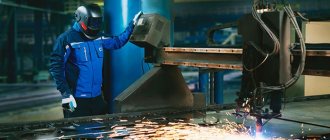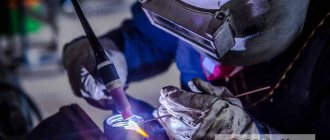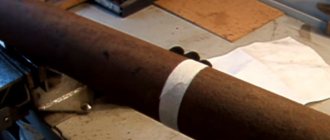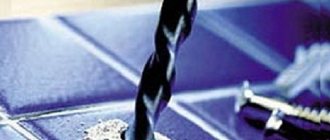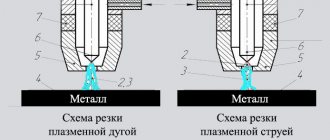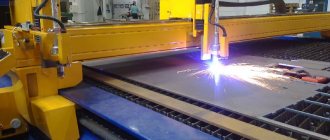03/30/2020 Author: VT-METALL
Issues discussed in the material:
- How to determine the quality of plasma cutting
- What other plasma cutting quality criteria should be taken into account?
- What defects reduce the quality of plasma cutting of metal?
- 9 Secrets to Improving Plasma Cutting Quality
The quality of plasma cutting is determined in accordance with such parameters as the cutting angle, the color of the processed workpiece, the amount of scale, and surface quality. These properties can be influenced by correctly setting up the equipment and following the rules of metalworking.
An incorrectly set angle, too high or low processing speed, or the amount of gas supplied - all this can reduce the quality of the work performed and lead to the formation of defects. What you need to pay attention to when performing plasma cutting to reduce the defect rate, we will discuss in this article.
How to determine the quality of plasma cutting
Modern plasma torches, equipped with numerical control, make possible high-precision positioning of the electric arc with a plasma flow (the working fluid of the machine) down to 0.5 mm. Cutting in such devices is carried out in accordance with the templates loaded into the program - this also has a positive effect on the quality and accuracy of the product cut.
When processing a workpiece using a plasma cutting machine, the edges are clean: no scale or sagging is formed on them. This is due to the fact that the plasma flow washes away the liquefied metal during operation. Unlike cutting with the oxygen-gas method, the plasma torch heats only a limited working area, thin rolled products are not deformed, and the cut is smooth, without jagged edges.
Unlike an oxygen-gas cutting machine, which is only suitable for working with ferrous metals (due to oxidation of the edges during cutting), the plasma torch provides high quality plasma cutting when processing all types of metal that conduct current: aluminum, titanium, copper, low-carbon and stainless steel, cast iron, etc. CNC units allow you to set individual settings for the current strength and plasma gas supply for different types of material and thickness of workpieces.
We recommend articles on metalworking
- Steel grades: classification and interpretation
- Aluminum grades and areas of their application
- Defects in metal products: causes and search methods
The classification of types of thermal cutting, its quality and geometric parameters of the product are reflected in the European quality standard EN ISO 9013 “Thermal cutting”.
The document is used for plasma cutting, laser and oxygen. In this case, the thickness of rolled products for a plasma torch should vary from 1 to 150 mm, for a laser cutter - from 0.5 to 40 mm, for an oxygen machine - from 3 to 300 mm. The EN ISO 9013 Thermal Cutting standard defines geometric cutting parameters and dimensional tolerances.
The quality of plasma cutting is determined by the following criteria:
- average difference in height from troughs to peaks;
- degree of unevenness and angular tolerance.
You can visually determine the quality of products taking into account:
- spaces between furrows;
- melting edges.
Company advantages
Why should you contact GOST Metal? The following advantages speak in our favor:
- Many years of experience in the production of rolled metal of various configurations and sizes. We have been providing quality services for more than 10 years.
- The company has at its disposal an extensive fleet of modern plasma welding equipment, including CNC equipment. The machines were supplied by well-known domestic and foreign manufacturers.
- The company employs experienced, highly qualified employees at all stages of preparation, design and manufacturing of products.
- Great possibilities for metal processing. We are capable of processing parts from almost any material, any size and configuration. We provide processing of large batches of products. Capable of producing shaped and artistic cutting.
- Strict compliance with all current standards. Quality control at all stages of work, starting with incoming control of raw materials.
- High quality. High precision edge processing after cutting is guaranteed.
During its activity, our company has already processed more than 1 million m2 of metal products without receiving any significant complaints. Every month we receive more than 100 orders for plasma cutting, but we are ready to significantly increase volumes.
The company is ready to work with customers in any region of the Russian Federation. Our managers will always provide the necessary information, conduct professional consultation and accept orders.
What other plasma cutting quality criteria should be taken into account?
- Burr formation at the bottom of the cut and spatter at the top of the cut.
Burr is cooled metal or metal oxide that adheres to the bottom edge during operation of the plasma torch. Spatter may form on the top of the edge. Burr can appear when the cutting speed is inappropriate, the distance between the plasma cutter and the workpiece is incorrect, the parameters of current and voltage are incorrectly selected, the quality and intensity of the supply of plasma-forming gas, or during technological process violations.
The quality of plasma cutting also depends on the composition of the rolled product, its thickness, the condition of the workpiece surface, and temperature fluctuations during operation. Burr can be caused by the torch speed being too high or too low. As a rule, there is a certain speed range, when operating at average values of which such defects do not form. The plasma gas and cutting method also play an important role.
- Angular deviation.
When working on a plasma torch, the edge of the product becomes slightly inclined. This occurs due to the temperature difference in the plasma arc sections. So, at the upper edge of the cut its temperature is higher, so more material is removed here than in the lower part. The angle of inclination of the cut directly depends on the degree of compression of the arc. The quality of plasma cutting in this aspect is also determined by the distance between the torch and the workpiece and the speed of its movement. As a rule, when using a plasma torch, the angular deviation on both sides is 4–8°.
VT-metall offers services:
With increased arc compression, the edge angle can be reduced to 1°. In this case, the elements of the product have a common cut.
- Cutting width.
According to practical rules of cutting, the cutting width should vary between 1.5-2 times the diameter of the cutting jet. The quality of plasma cutting on this side directly depends on the speed of the knife - the lower it is, the greater the width.
Installation cost
Often the final decision on whether to equip a production facility with a laser or plasma is influenced by the cost of installation and operating costs.
To correctly understand the issue of the cost of laser and plasma installations, we will assume that it is assumed that metal of the same thickness will be cut at the same speed. At the same time, at thicknesses up to 4..6 mm, a laser system is approximately 4..6 times more expensive than a plasma one; with a thickness of 6..20 mm, the difference in price is already 10 times or more.
When cutting metal with a thickness of more than 20 mm, the use of laser cutting becomes available only to large industries with unique specific tasks.
The coordinate system for a laser installation is subject to increased requirements for dynamic and accuracy characteristics; accordingly, it is necessary to use components of higher accuracy. As a result, the cost of a laser coordinate system is 3..4 times higher.
What defects reduce the quality of plasma cutting of metal?
Below we will look at product defects that may be caused by incorrectly set cutting parameters or violations of the plasmatron operating technology, and we will also talk about ways to get rid of them.
- Angularity.
This parameter means the degree of inclination of the cut when processing the workpiece on a plasma torch. Angularity may appear due to uneven heating of the sheet across its thickness. The fact is that the plasma arc releases an unequal amount of heat along its entire length, so different amounts of material are melted at different rolling depths.
- Scale.
This is metal that melted during cutting, which, having hardened, stuck to the edge of the product. Scale is also called slag. The quality of plasma cutting in this sense depends on consumables, cutting settings, air cleanliness in the workshop - these parameters determine the volume of scale formed and the difficulty of cleaning it off.
- Surface quality.
This parameter is determined by the degree of surface roughness - the total number of irregularities located close to each other within the cast. In other words, this is the degree of its smoothness. It is this that determines the most important user properties of the workpiece.
Performance
Considering productivity, it should be noted that when cutting parts made of thin sheet metal (up to 2..3 mm) with a large number of holes, grooves, etc., a powerful high-speed laser is most effective. However, at thicknesses of more than 6 mm, plasma wins in terms of cutting speed, and for sheet thicknesses of 20 mm and above, it has no competition.
The basic rule is that, with the same power consumption of the installations, plasma cutting is 2..3 times more productive than laser cutting – in the manufacture of simple parts. At the same time, it is still more expedient to produce large batches of the same type of complex parts from thin metal using a laser, because the cut parts can be applied to the following technological operations without additional processing (descaling).
Brief information about plasma
Plasma is a gas that is ionized to varying degrees. Ionization can be complete or partial - even a weakly ionized gas (less than 1% of ionized particles) exhibits some properties of plasma. There are isothermal and gas-discharge plasma, the type of plasma depends on the method of its formation. Isothermal plasma is formed when a gas is heated to a temperature at which the process of thermal ionization of the gas begins. Gas-discharge plasma, in turn, is formed as a consequence of an electric discharge (electric arc) in a gas. The most common example of such a discharge is lightning.
Equipment used
The following equipment is required for plasma cutting:
- source of electricity. Typically, a plasma cutter is connected to either a transformer or an inverter. An inverter is better in all respects (efficiency, efficiency, arc stability) than a transformer. Except for one thing - when powered by an inverter, a plasma cutter is not capable of cutting a product of large thickness;
- The plasmatron is the “heart” of the device. It consists of an arc (plasma-forming) chamber, an electrode, a nozzle, gas and water supply systems;
- compressor - necessary to direct the air stream strictly along the axis of the plasma flow.
Sharp cumulative jet
One of the main methods of cutting metals by explosion is based on the use of the phenomenon of formation of cumulative jets. Small charges are used to punch holes at great depths in pipes during oil and gas production. Shaped charges are also used to destroy large reinforced concrete masses and stone monoliths.
a - shaped charge diagram;
Read also: Diamond pencil holder
b - diagram of the formation of a cumulative jet;
c - diagram of penetration of an obstacle by a cumulative jet
Explosion cutting of thick metals is successfully used for processing used equipment, large objects, and bridges. Moreover, in the latter case, these operations can be carried out under water. This technology, like other types of blasting, does not require expensive equipment, and the cost of explosives is relatively low.
Features of cutting thick metals
The machinability of cutting thick metals is influenced by the technological conditions of its processing. First of all, you should pay attention to the rigidity of the technological cutting system. If the rigidity of the system is reduced, vibrations occur, as a result of which the actual cutting speed increases due to the imposition of the speed of the oscillatory process of the cutting edge of the tool. Depending on the rigidity of the cutting system, the actual speed can increase by 15...40%, significantly reducing tool stability when cutting difficult-to-cut metals that are very sensitive to changes in cutting speed. Possibilities for increasing the rigidity of the technological system include changing the part fastening scheme, reducing cutter overhang, increasing tool rigidity, using vibration damping devices, and the like. For thick and difficult-to-cut metals, it is necessary to look for combinations of operating and other technological factors that would improve the ductility of the material being processed in combination with its heating in the cutting zone.
Another direction is additional external stimulation (application of ultrasonic vibrations, introduction of electric current, etc.).
The physical mechanism of the process of thick cutting of metals, which is based on the dislocation-energy laws of plastic deformation and destruction, makes it possible to explain the nature of some known methods for improving machinability, for example, heating the material being processed during the cutting process. This method usually leads to a decrease in the hardness of difficult-to-cut materials. The deformation process is also facilitated by the growing role of thermal activation of dislocations overcoming barriers and the development of diffusion processes.
As an alternative to a significant number of criteria, one general or integral indicator of machinability and optimal cutting can be proposed in the form of the specific energy intensity of the process, based on determining the energy spent on removing a unit volume of allowance. It is advisable to implement the application of the energy criterion for practical problems of optimal assignment of technological conditions for cutting parts.
The energy for plastic deformation of the cutting zone is distributed unevenly and depends on the cutting conditions and tool geometry. The greatest costs usually fall on the deformation of the metal above the cut surface (95% or more of the work of plastic deformation).
From this we can conclude: to improve machinability, it is enough to reduce the hardness of the metal layer that is being removed.
Improving the machinability of metals and alloys before or during machining is an important effective means of controlling the cutting process, as well as a means of achieving minimization of energy costs.
By controlling machinability, it is possible to prescribe cutting conditions that will be optimal from all points of view: chip resistance, tool life, and processing quality.
Depending on the thickness of the metal and the form of processing, the edges are prepared by trimming with scissors, mechanical planing or gas cutting. The most common are mechanized gas cutting (in factory conditions) and manual gas cutting (in installation conditions). After gas cutting, the surface of the workpiece requires mechanical treatment to remove cutting marks. And for some steels (martensitic-ferritic class), after gas cutting it is necessary to mechanically remove a layer of metal at least 1-2 mm thick, so before cutting it is necessary to provide an allowance. Flame and air-arc cutting is used to process high-alloy steels.
- There are many types of edge cutting:
- Butt connection without developing edges;
- Butt joint with double-sided symmetrical edge processing or joint with K-groove;
- Butt joint with one-sided groove of one edge;
- Butt joint with one-sided symmetrical groove of two edges or connection with V-shaped groove of edges;
- Butt joint with two-way symmetrical processing of two edges or joints with X-shaped edge preparation;
- Butt joint with one-sided symmetrical cutting of two edges at different angles. As a rule, it is used when welding pipelines with a wall thickness of 10 mm and above.
To manufacture parts of particularly critical structures with edges of a certain configuration, lathes, pipe cutters and other mechanical equipment are used. You can also use manual mechanical cutters and abrasive machines if the design is not particularly critical or its dimensions allow you to resort to this type of processing.
To obtain a workpiece ready for assembly, it must be cleaned to eliminate irregularities formed during the rolling process and transportation.
Cleaning is performed before assembly of the unit mechanically or chemically. The surface areas of parts that require cleaning are shown below:
During this type of hot work, pops and backfires may be observed, which can lead to a rupture of the hose and a fire.
Kickbacks occur under the following conditions:
- overheating of the mouthpiece;
- fuel getting into the oxygen hoses;
- if the rate of flow of the flammable mixture from the mouthpiece becomes less than the combustion rate;
- loosening the union nut of the mouthpiece or mixing chamber.
Ignition and explosion of the oxygen hose in the event of a kickback occurs if liquid fuel enters the oxygen tube and hose.
When manufacturing metal structures from non-ferrous metals, the need arises for cutting them. While making straight and some curved cuts can be achieved by mechanical methods in a cold state and does not cause difficulties, cutting thick metal, making shaped parts, holes, and surface treatment always involves the use of thermal cutting methods.
Read also: Lost wax casting method
Plasma cutting is accompanied by strong noise, which, combined with the ultrasonic effect, is dangerous for operating personnel.
What is plasma used for and what is laser used for?
The laser is suitable where accuracy, cleanliness of cuts and edges and speed are needed. And plasma cuts slowly, relative to a laser, and with a dirty cut, so it is impossible to cut out complex technical parts. And on a metal laser machine it is possible to cut, for example, small nameplates and plates, thin grilles and complex design elements, as well as rotary wheels.
Plasma is needed to make simple products. In the shape of a rectangle, oval or square, because they can be processed later. But cutting out a star with holes inside will be difficult. Plus, sanding will take a lot of time. And post-processing equipment will cost several times more than a metal cutter.
Plasma is used where there are large thicknesses and for simple cutting, for example, rails, metal frame elements or welded structures, etc.
Oxygen cutting
Oxygen cutting in many cases is mechanized using special
portable devices and gas cutting machines. When using oxy-fuel cutting, not only acetylene is used, but also other flammable gases, such as natural and petroleum gases, hydrogen, as well as liquid fuels - kerosene and gasoline.
Oxy-fuel cutting is superior in quality and productivity to many other cutting methods, which is why it is widely used.
Also important is the method of cutting with an oxygen lance, which is used when sawing through metal in metallurgical furnaces, creating holes in concrete, etc. Cutting with an oxygen lance is performed using a low-carbon steel tube into which oxygen is supplied to the cutting site. First, the cutting site and the end of the tube are heated with the flame of a gas welding soldering iron, and then oxygen is supplied to the tube. When the end of the tube lights up, it is pressed to the cutting site and the cutting process is carried out due to the combustion of the metal of the tube and the product in a stream of oxygen.
Pros and cons of plasma and laser
Plasma
Advantages:
- Wide range of cut thicknesses from 0.5 to 50 mm per punch ;
- High cutting speed at large thicknesses;
- Low initial price of equipment
- Well-proven technology for cutting at an angle, as they are now used to calling it, cutting with a bevel.
Flaws:
- It is inappropriate to process metals thinner than 1 mm;
- Edge taper up to 5 degrees (poor quality edge);
- The presence of scale on the holes when turning, so additional processing of the products is required;
- Restriction on hole diameter up to 4 mm;
- High cost of consumables;
- Low accuracy compared to a laser machine;
- Requires post-processing;
- Low cutting speed compared to laser on thin materials;
- Inability to perform many types of cutting available to a laser machine.
Laser
Advantages:
- Edge perpendicularity;
- Small cutting width;
- No scale - you get a 100% finished product;
- The diameter of the hole is less than the thickness of the sheet. You can cut out small parts down to 1 mm;
- Low thermal impact on the edge;
- Cheap consumables;
- Processing of thin metal from 0.2 mm;
- Highest possible cutting speed;
- The materials require no post-processing and are ready to be welded, painted or packaged and then sold.
Flaws:
- You can cut metal only up to 20 mm;
- High initial price of equipment.
How does a plasma torch work?
The process of formation of a plasma arc occurs approximately as follows.
An electric discharge occurs between the nozzle and the plasmatron electrode and the so-called pilot arc is ignited. It is blown out through the nozzle and touches the metal surface being cut. A short circuit occurs between the electrode and the metal, and a real arc is created, which heats and ionizes the gas supplied to the plasma-forming chamber. The resulting plasma flow is blown out of the nozzle. The vortex gas narrows and concentrates the plasma, preventing it from touching the nozzle walls. The plasma speed ultimately reaches 2-3 km per second, and the temperature reaches 30 thousand degrees.
Processing of non-ferrous alloys
When processing non-ferrous metals, various cutting methods are used, taking into account the density of the material, its type and other technical indicators. To cut non-ferrous metals, the following recommendations must be followed:
- Cutting aluminum - for material up to 7 cm thick, compressed air can be used. Its use is impractical when the material density is low. High-quality cutting of aluminum sheets up to 2 cm is achieved using pure nitrogen, and with a thickness of 7-10 cm using hydrogen and nitrogen. Plasma cutting of aluminum with a thickness of more than 10 cm is carried out using a mixture of hydrogen and argon. The same composition is recommended to be used for thick-walled high-alloy steel and copper.
- Cutting stainless steels - the use of compressed air is not recommended for the work; taking into account the thickness of the material, pure nitrogen or mixtures with argon can be used. It should be taken into account that stainless steel is quite sensitive to alternating current, which can lead to changes in its structure and faster decommissioning. Stainless steel cutting is carried out using an installation that uses the principle of indirect action.
Guillotine cutting
Guillotine cutting is a straight-line cutting of sheet metal. The metal is cut by opposing blades of two knives.
During cutting, the movable knife moves in relation to the stationary one with a gap determined by the cutting conditions.
The movable knife can be set at an angle relative to the stationary one so that cutting occurs sequentially, from one side to the other. This angle is called the angle between the knives, reduces the cutting force, but increases the stroke of the movable knife.
A guillotine is a device that consists of a frame with a work table, a sheet clamping system, upper and lower knives and a back stop. The back stop ensures the desired size of the part that is being cut.
The clearance angle of the upper knife has little effect on cutting force. When using 2 blades with 4 cutting edges, higher cutting forces are required than when the upper blade is set with a small clearance angle (usually no more than 3°).
The angle between the blades significantly affects the cutting force and affects defects. This angle should not be more than 3°.
The gap between the knives is the perpendicular line between them. The cleanliness of the cut depends on the thickness of the sheet. If the gap is too small, there is increased wear on the knives, which requires sharpening costs. If the gap is too large, the metal is crushed between the two knives. As a result, we get a cone-shaped cut and plastic deformations in the material.
Common disadvantages of guillotine cutting are: twisting, saber-shaped, bending and non-straightness of the edge.
Guillotine shears for cutting thick metal are used for sheets up to 5 mm thick. The edge is smooth, but it is important to maintain a gap between the blades of 0.03 mm.
What consumables are needed?
For plasma cutting machine
On plasma it is necessary to change nozzles, electrodes, protective screens, and casings. And on the laser there are only lenses and a nozzle.
For laser machine
But when working on a laser machine, it is necessary to change the lens and nozzle every two weeks. The lens costs 700 rubles, the nozzle costs 900 rubles.
The maximum monthly payment for consumables for a laser machine will be 3,200 rubles.
So let's summarize.
